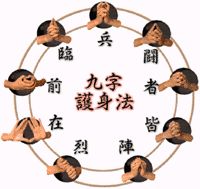
Ninjutsu originated in the Buddhist temples of Japan.
There was a time in Japanese history, where people who practiced
the indigenous faith feared the new religion entering their land from China.
That new religion was Buddhism.
Sohei ( warrior monks ) practiced Himitsu Kempo, a combination of
Jujitsu and the art now known as Ninjutsu.
Ninjutsu is the very specialized art of learning how to covertly
enter and exist all types of places.
It is the art of espionage and counter-espionage.
At times it can be applied to guerrilla warfare, where a small force
can infiltrate the enemy castle or province.
In Tenshin Shoden Katori Shinto-ryu, Ninjutsu was taught as part
of a samurai system.
However, those who practiced Ninjutsu at that time was samurai,
and not ninja.
That was because ninja at that time were considered as scum, while
samurai had status in the feudal society.
Kempo has always been preserved for the development of Ninjutsu.
Out of the spiritual training of patience develops the stillness
of body necessary for the advanced espionage skills.
Kiyojute-ryu Kempo Bugei contains Ninjutsu skills based on the ancient
spiritual practices of the Sohei, warrior monks.
Other skills include : Suieijutsu ( swimming skill ) Hichojutsu
( leaping-flying skill ); Hayagakejutsu ( swift running skill ); Karumijutsu
( body lightening skill );
Shinobiirijutsu ( stealth entering skill ); Shinobiderujutsu ( stealth
escape skill ); and Shinobisugatajutsu ( stealth disguise skill ).
In Koga-ha Kosho Shorei-ryu, adopted Zen principles for developing
the advanced physical and mental abilities.
Koppo, the bone art, based on the footwork of Karumijutsu, develops
the athletic ability along with physical skill and coordination.
Gogyo, the five elements, are studied as ways of developing analytical
strategy in regard to personal combat and battlefield tactics.
The Gogyo also helps in the development of the mental attitude so
that any situation can be handled since all things have strengths and weaknesses.
Other forms of mental training, developed through the practice of
the physical skills, are Mushin, Honshin and Zanshin.
It is these mental attributes which are so special to the Zen-based
martial arts, with Ninjutsu being no exception.
Mushin is the no mind, referring to abolishing all extraneous thoughts,
which interfere with the perception of reality.
This leads to Honshin, the right mind, which allows the practitioner
to make correct choices, in both combat and life.
Finally, there is Zanshin, the ever present mind, or more simply
the surviving mind.
This is the awareness and living mind of the practitioner who now
is ready to enter the spiritual realm.
At this level, all things are related to Ki.
Nimpo, as the principle of patience, was related to Haragei, the
spiritual art, which is the art of the energy field.
Sensing beyond the five senses, it leads to Kijutsu, the aspect
of expansion and contraction of the energy field for application in fighting
techniques.
Kiaijutsu is the spiritual harmony art involved in focusing all of
ones strength into one point for a powerful technique, be it a strike,
throw, or kick.
In the Okinawan arts, this was the primary principle, which could
have come to the systems through a Japanese influence.
The highest level of spiritual training could be seen in the arts of Aikijutsu, Kimejutsu and Shimmejutsu.
Aikijutsu, refers to the projection of such love that any sane person
would refrain from combat due to the feeling of compassion sensed from
the other person.
It was said that such a skill could also stop a charging animal
from attacking.
Kimejutsu is the spirit eye skill.
According to tradition it was possible to focus your inner intent
into your eyes so that an opponent.
He could then be psychologically overwhelmed, made to flee, frozen
in fear, or put at ease.
Shimmejutsu is the art of seeing with the eyes of God.
Some felt this showed the ultimate goal of training, in the religious
sense was to be one with the creator,
seeing the creation as he saw it, thus having a greater understanding
of man in his place as a part of the whole.
Only the one who has achieved it can hope to understand it.
Ninja no Hachimon ( The Eight Gates of the Ninja )
Besides fighting and espionage skills, Ninja no Hachimon was something all Ninja had to be familiar with.
| 1. Ninja no Kiai ( Voice Harmonization )
2. Ninja no Taijutsu ( Koshijutsu/Koppojutsu ) 3. Ninja no Ken ( Ninja Sword Skills ) 4. Ninja no Yari ( Ninja Spear Skills ) 5. Shurikenjutsu ( Throwing Blade Skills ) 6. Kajutsu ( Fire, Smoke and Explosive Skills ) 7. Kyomon ( Observational Skills ) 8. Yugei ( Etiquette; Example : Tea Ceremony ) |
The ninja are trained in 5 major disciplines :
| 1. Food
2. Odour 3. Medicine 4. Ki ( Kujihou ) 5. Body |
